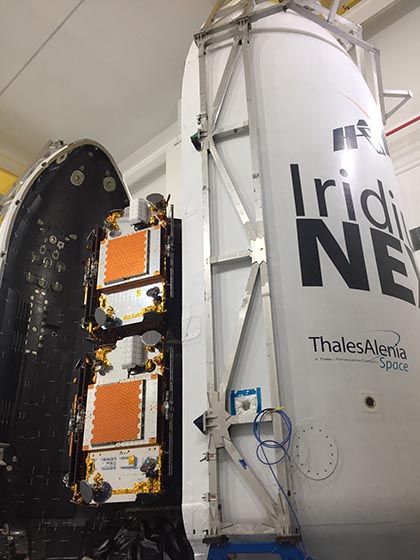Iridium launch to make history
Dec. 22 mission reuses SpaceX rocket
Iridium Communications Inc. is making final preparations for its next launch. Iridium-4 is scheduled to lift off from Vandenberg Air Force Base, California, at 5:32 p.m. Pacific Standard Time Dec. 22. The backup launch date is Dec. 23. The company said the launch marks the midway point of its launch campaign with SpaceX, lofting the fourth set of 10 Iridium NEXT communication satellites, and will be the first Iridium launch to reuse a “flight-proven” SpaceX Falcon 9 rocket.
The launch will use the same Falcon 9 rocket first stage that carried 10 Iridium NEXT satellites on the company’s second launch, in June 2017. Iridium said the launch will make it the first company in history to reuse the same rocket.
“We’re approaching our halfway point on this journey, and with each launch, we gain more momentum,” said Iridium CEO Matt Desch. “This launch will bring us to 40 Iridium NEXT satellites in space, which is more than half the number required for a full Iridium NEXT operational constellation. It has been remarkable to witness the increased speed, capacity, and throughput of our network as we continue to replace our original satellites with new Iridium NEXT satellites.”
Iridium says that it is fully confident in the SpaceX booster refurbishment program. “I believe that reusability is the future for satellite launches, and I think SpaceX has intelligently built their Falcon 9 program around this strategy,” Desch said. “With three successful flight-proven Falcon 9 launches already this year, we’re excited to show leadership towards the sustainable access to space, while also making sure we maintain our cadence to complete the five remaining Iridium NEXT launches by the middle of next year.”

Iridium confirmed with its insurers that there is no increase in premium for the launch program as a result of reusing Falcon 9 rockets, reinforcing the company’s conclusion that the risk profile is unchanged, Iridium said in a news release. Iridium will reuse a Falcon 9 for its fifth launch, as well.
The operational Iridium constellation will be composed of 66 satellites divided into six polar orbiting planes, with 11 satellites in each plane. Destined for Iridium orbital plane two, nine of the 10 Iridium NEXT satellites deployed during this launch will immediately go into service following testing and validation. The remaining satellite will undertake a nearly year-long journey to orbital plane one, where it will serve as a spare satellite.
Iridium has contracted with SpaceX to deliver 75 Iridium NEXT satellites to orbit, 66 operational and nine on-orbit spares, through a series of eight launches. Iridium NEXT is the company’s $3 billion next-generation global, mobile satellite network scheduled for completion in 2018. Iridium NEXT will replace the company’s existing global constellation in what it says is one of the largest technology upgrades ever completed in space.




